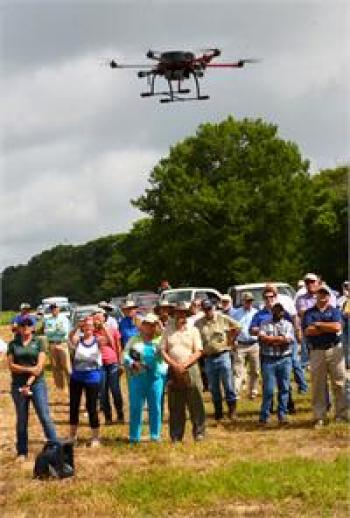Wanted: New herbicides for stubborn weeds
Farmers and crop consultants attending a field day at the LSU AgCenter Northeast Research Station learned about new herbicide technologies that will help control stubborn weeds in their soybeans.
Researchers gave talks about their projects with soybeans as well as cotton and corn during the field tour with more than 150 people in attendance.
Donnie Miller, LSU AgCenter weed scientist and coordinator of the station, said Dow AgroSciences has developed the Enlist weed control system for soybeans that imparts tolerance to 2,4-D, while Monsanto has developed the Roundup Xtend weed control system for dicamba tolerance. BASF is also developing a dicamba formulation to use with the Xtend soybean system. Limited release in Louisiana in 2015 of the cropping systems is anticipated.
“They are at various stages in the regulatory process,” Miller said.
But Miller cautioned these systems will provide maximum benefit only when applied to small actively growing weeds.
“These are weed management technologies, not rescue or salvage technology,” he said, adding that dicamba and 2,4-D offer good alternatives for controlling pigweed and Palmer amaranth that have become resistant to glyphosate.
Beatrix Haggard, LSU AgCenter soil specialist, and her graduate student, Shanice Jones, talked about their work to improve fertilizer efficiency. Jones said use of a urease inhibitor resulted in the highest yields for corn, while a nitrification inhibitor had the lowest yields, compared with other inhibitors.
Haggard said nitrogen losses are unpredictable and variable because of inconsistent weather. She said her work is aimed at keeping fertilizer recommendations current so farmers can get the optimum results without spending more money than necessary.
Randy Price, LSU AgCenter engineer, demonstrated the use of unmanned aerial vehicles, or drones, in agriculture. He said drones are becoming more popular to survey and scout fields. He said short battery life limits the use of most affordable devices.
Rick Mascagni, LSU AgCenter agronomist, said he is testing two new corn hybrids that have shown promise so far. He said corn planting was late because of weather.
Josh Lofton, LSU AgCenter agronomist, said planting soybeans after wheat requires a clean seedbed. He said his test showed that burning wheat stubble resulted in the best yields, while no-till had the lowest yields at the Northeast Research Station.
Lofton said soybeans that lack nodulation on the roots are starved for nitrogen. The roots of soybean plants at the R-3 stage should have 18-20 nodules, he said.
Sebe Brown, LSU AgCenter entomologist, said tobacco thrips in cotton were found to be resistant to Cruiser pesticide. He said alternatives, such as Gaucho, are available.
David Kerns, LSU AgCenter entomologist, said the sugarcane aphid is showing up in sorghum. He said the pest can wipe out a crop, and a grower near DeRidder had a 70 percent loss last year. “This thing has spread all through Louisiana.”
He said federal approval has been granted for the use of Transform insecticide with two applications of 1 ounce per acre. Treatment should be made when 30 percent of a plant is covered, or 100-200 aphids are found on a leaf.
Ron Levy, LSU AgCenter soybean specialist, said Louisiana’s soybean crop, approximately 1.2 million acres, is showing potential for a good year. “We’re hoping for the third record year in a row.”
But, he said, many farmers in south Louisiana have been unable to plant or have replanted two or three times because of bad weather.
Dan Fromme, LSU AgCenter cotton specialist, said the Louisiana cotton crop will probably total 160,000 to 170,000 acres this year, compared to only 125,000 acres last year. He said 90 percent of the crop was planted by May 20, and most plants should be blooming within 10-14 days.
Trey Price, LSU AgCenter plant pathologist, said corn and cotton diseases started early. “This has been a seedling disease year.”
Eric Webster, LSU AgCenter weed scientist, said he is testing nine experimental herbicides. Three have unique modes of action that could be helpful in managing weeds that have become resistant to current herbicides, he said.
Webster said he has received many reports of herbicide drift. “Early in the morning is probably the worst time to spray.”
Bill Richardson, LSU vice president for agriculture, said the field day demonstrated the need for research and extension to work together closely. He said this year’s budget issues are less critical than the LSU AgCenter has faced previously.
Rogers Leonard, LSU AgCenter vice chancellor for plant and soil sciences, said hiring a team of three water resource experts, based at the Red River Research Station near Bossier City, shows the LSU AgCenter’s recognition of water resources as a priority. The team will work on water quality and efficiency issues, he said.
Dr. Mike Strain, commissioner of the Louisiana Department of Agriculture and Forestry, said the Legislature’s approval of new checkoff systems for soybeans, rice, crawfish and boll weevil protection will ensure that research stations have a reliable funding source from producers. No legislator voted against the measures, he said.
Tara Smith, director for the LSU AgCenter’s Northeast Region, said Cotton Inc. and the Soybean and Grain Research and Promotion Board helped fund many of the projects shown at Tuesday’s field day.
Ray Schneider, a farmer in Pointe Coupee Parish and a member of the grain board, said the funds are paid by growers, while the board decides how the money is spent. “We just pull the trigger on the ones that should be funded.”
- Log in to post comments

